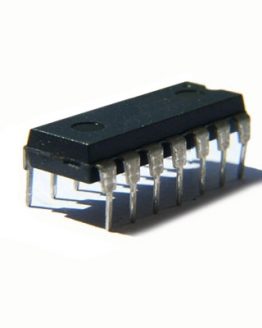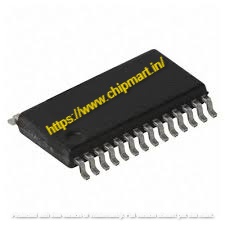CD74HCT123E
The ?HC123, ?HCT123, CD74HC423 and CD74HCT423 are
dual monostable multivibrators with resets. They are all
retriggerable and differ only in that the 123 types can be
triggered by a negative to positive reset pulse; whereas the
423 types do not have this feature. An external resistor (RX)
and an external capacitor (CX) control the timing and the
accuracy for the circuit. Adjustment of Rx and CX provides a
wide range of output pulse widths from the Q and Q
terminals. Pulse triggering on the A and B inputs occur at a
particular voltage level and is not related to the rise and fall
times of the trigger pulses.
Once triggered, the output pulse width may be extended by
retriggering inputs A and B. The output pulse can be
terminated by a LOW level on the Reset (R) pin. Trailing
edge triggering (A) and leading edge triggering (B) inputs
are provided for triggering from either edge of the input
pulse. If either Mono is not used each input on the unused
device (A, B, and R) must be terminated high or low
CD74HCT123M
The ?HC123, ?HCT123, CD74HC423 and CD74HCT423 are
dual monostable multivibrators with resets. They are all
retriggerable and differ only in that the 123 types can be
triggered by a negative to positive reset pulse; whereas the
423 types do not have this feature. An external resistor (RX)
and an external capacitor (CX) control the timing and the
accuracy for the circuit. Adjustment of Rx and CX provides a
wide range of output pulse widths from the Q and Q
terminals. Pulse triggering on the A and B inputs occur at a
particular voltage level and is not related to the rise and fall
times of the trigger pulses.
Once triggered, the output pulse width may be extended by
retriggering inputs A and B. The output pulse can be
terminated by a LOW level on the Reset (R) pin. Trailing
edge triggering (A) and leading edge triggering (B) inputs
are provided for triggering from either edge of the input
pulse. If either Mono is not used each input on the unused
device (A, B, and R) must be terminated high or low.
CD74HCT132M
LSTTL input logic compatible
? VIL(max) = 0.8 V, VIH(min) = 2 V
? CMOS input logic compatible
? II
? 1 ?A at VOL, VOH
? Buffered inputs
? 4.5 V to 5.5 V operation
? Wide operating temperature range:
?55?C to 125?C
? Supports fanout up to 10 LSTTL loads
? Significant power reduction compared to LSTTL
logic ICs
CD74HCT166E
The ?HC166 and ?HCT166 8-bit shift register is fabricated
with silicon gate CMOS technology. It possesses the low
power consumption of standard CMOS integrated circuits,
and can operate at speeds comparable to the equivalent low
power Schottky device.
The ?HCT166 is functionally and pin compatible with the
standard ?LS166.
The 166 is an 8-bit shift register that has fully synchronous
serial or parallel data entry selected by an active LOW Parallel
Enable (PE) input. When the PE is LOW one setup time before
the LOW-to-HIGH clock transition, parallel data is entered into
the register. When PE is HIGH, data is entered into the internal
bit position Q0 from Serial Data Input (DS), and the remaining
bits are shifted one place to the right (Q0 ? Q1 ? Q2, etc.)
with each positive-going clock transition. For expansion of the
register in parallel to serial converters, the Q7 output is connected to the DS input of the succeeding stage
CD74HCT20E
? LSTTL input logic compatible
? VIL(max) = 0.8 V, VIH(min) = 2 V
? CMOS input logic compatible
? II
? 1 ?A at VOL, VOH
? Buffered inputs
? 4.5 V to 5.5 V operation
? Wide operating temperature range:
-55?C to 125?C
? Supports fanout up to 10 LSTTL loads
? Significant power reduction compared to LSTTL
logic ICs
CD74HCT32E
? LSTTL input logic compatible
? VIL(max) = 0.8 V, VIH(min) = 2 V
? CMOS input logic compatible
? II
? 1 ?A at VOL, VOH
? Buffered inputs
? 4.5 V to 5.5 V operation
? Wide operating temperature range:
-55?C to 125?C
? Supports fanout up to 10 LSTTL loads
? Significant power reduction compared to LSTTL
logic ICs
CH376S
CH376 is a file manage control chip that allows MCU systems to read and write files from USB flash drives or SD cards. CH376 supports both USB-Device and USB-HOST modes. Install the USB communication protocol's fundamental firmware on the inside. It also includes firmware for dealing with Mass-Storage devices, communication interface firmware for SD cards, and FAT16, FAT32, and FAT12 file system management firmware. It supports popular USB storage devices (including USB Flash Drives, USB hard discs, USB Flash memory, and USB read cards) as well as SD cards (contain SD card with standard capacity and HC-SD card with high capacity, MMC card and TF card compatible with protocol).
CH376 offers three additional features: 8-bit parallel, SPI, and asynchronous serial. DSP/MCU/MPU controllers use any interface to operate the CH376 chip, save and retrieve data from a USB Flash Drive or SD card, or communicate with a computer.
CH376's USB-DEVICE Mode is fully compatible with CH372, but CH375's USB-HOST Mode is only partially compatible with CH375.
Features
USB-HOST and USB-DEVICE Modes, which automatically transition between Host and Device Modes.
USB device control transfer, bulk transfer, and interrupt transfer are all supported.
Automatically detects and unplugs USB devices and sends a message to the USB host.
SPI host interface with 6MHz support, SD card, MMC card, and TF card protocol compatible.
Set the USB control transfer protocol manager in the inner to ease common control transmission.
Install firmware for a particular communication protocol related to mass storage. Supports Bulk-Only transfer protocol and USB storage devices of SCSI, UFI, RBC, and other comparable storage devices that support the bare minimum of commands, such as USB Flash Drive, USB HD, USB flash memory, and USB reader.
Set the file system management firmware of FAT16, FAT32, and FAT12, and support up to 32GB USB Flash Drive and SD Card.
Provide file management functions such as opening, creating, and deleting files, enumerating and searching files, creating sub-catalogs, and supporting extended file names.
Provide file read/write function: read/write file in the much longer sub-catalog using byte or fan as unit.
Supply disc management functions: initialise disc, query physical capacity, query spare space, read/write physical sectors
Supply an 8-bit passive parallel interface with a 2MB speed and the ability to connect a parallel data bus to an MCU.
SPI device interface with 2MB/24MHz speed, SPI serial bus connect to MCU support
Supply asynchronous serial interface with up to 3Mbps speed, serial interface connect to MCU, and automated communication adjustment

















